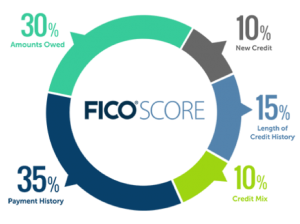by Farley Webmaster | Apr 11, 2018

From summer vacations to winter holidays, it seems each season offers the perfect excuse to put off our to-do list. But be careful, homeowners: neglecting your home’s maintenance could put your personal safety—and one of your largest financial investments—at serious risk.
In no time at all, small problems can lead to extensive and expensive repairs. And even if you avoid a catastrophe, those minor issues can still have a big impact. Properties that are not well maintained can lose 10 percent (or more) of their appraised value. The good news is, by dedicating a few hours each season to properly maintaining your home, you can ensure a safe living environment for you and your family … and actually increase the value of your home by one percent annually!1 You just need to know where and how to spend your time.
Use the following checklist as a guide to maintaining your home and lawn throughout the year. It’s applicable for all climates, so please share it with friends and family members who you think could benefit, no matter where their home is located.
Spring
After a long, cold winter, many of us look forward to a fresh start in the spring. Wash away the winter grime, open the windows, and prepare your home for warmer weather and backyard barbecues.
Inside
- Conduct Annual Spring Cleaning
Be sure to tackle those areas that may have gone neglected—such as your blinds, baseboards and fan blades—as well as appliances, including your refrigerator, dishwasher, oven and range hood. Clear out clutter and clothes you no longer wear, and toss old and expired food and medications.
- Shut Down Heating System
Depending on the type of heating system you have, you may need to shut your system down when not in use. Check the manufacturer’s instructions for proper procedures.
- Tune Up A/C
If your home has central air conditioning, schedule an annual tune-up with your HVAC technician. If you have a portable or window unit, be sure to follow the manufacturer’s instructions for proper maintenance.2
- Check Plumbing
It’s a good idea to periodically check your plumbing to spot any leaks or maintenance issues. Look for evidence of leaks—such as water stains on the ceiling—and check for dripping faucets or running toilets that need to be addressed. Inspect your hot water heater for sediment build up. Check your sump pump (if you have one) to ensure it’s working properly.3
- Inspect Smoke Alarm and Carbon Monoxide Detectors
Check that your smoke and carbon monoxide detectors are functioning properly. Batteries should be replaced every six months, so change them now and again in the fall. Follow the manufacturer’s instructions to test your individual devices. And even properly functioning devices should be replaced at least every 10 years, or per the manufacturer’s recommendation.4
Outside
- Inspect Perimeter of Home
Walk around your house and look for any signs of damage or wear and tear that should be addressed. Are there cracks in the foundation? Peeling paint? Loose or missing roof shingles? Make a plan to make needed repairs yourself or hire a contractor.
- Clean Home’s Exterior
Wash windows and clean and replace screens if they were removed during the winter months. For the home’s facade, it’s generally advisable to use the gentlest method that is effective. A simple garden hose will work in most cases.5
- Clean Gutters and Downspouts
Gutters and downspouts should be cleaned at least twice a year. Neglected gutters can cause water damage to a home, so make sure yours are clean and free of debris. If your gutters have screens, you may be able to decrease the frequency of cleanings, but they should still be checked periodically.6
- Rake Leaves
Gently rake your lawn to remove leaves and debris. Too many leaves can cause an excessive layer of thatch, which can damage the roots of your lawn. They can also harbor disease-causing organisms and insects.7 However, take care because overly vigorous raking can damage new grass shoots.
- Seed or Sod Lawn
If you have bare spots, spring is a good time to seed or lay new sod so you can enjoy a beautiful lawn throughout the remainder of the year. The peak summer heat can be too harsh for a new lawn. If you miss this window, early fall is another good time to plant.8
- Apply a Pre-Emergent Herbicide
While a healthy lawn is the best deterrent for weeds, some homeowners choose to use a pre-emergent herbicide in the spring to minimize weeds. When applied at the right time, it can be effective in preventing weeds from germinating. However, a pre-emergent herbicide will also prevent grass seeds from germinating, so only use it if you don’t plan to seed or sod in the spring.
- Plant Flowers
After a long winter, planting annuals and spring perennials is a great way to brighten up your garden. It’s also a good time to prune existing flowers and shrubs and remove and compost any dead plants.
- Mulch Beds
A layer of fresh mulch helps to suppress weeds, retain moisture and moderate soil temperature. However, be sure to strip away old mulch at least every three years to prevent excessive buildup.9
- Fertilize Lawn
Depending on your grass type, an application of fertilizer in the spring may help promote new leaf and root growth, keep your lawn healthy, and reduce weeds.10
- Tune Up Lawn Mower
Send your lawn mower out for a professional tune-up and to have the blades sharpened before the mowing season starts.11
- Inspect Sprinkler System
If you have a sprinkler system, check that it’s working properly and make repairs as needed.
- Check the Deck
If you have a deck or patio, inspect it for signs of damage or deterioration that may have occurred over the winter. Then clean it thoroughly and apply a fresh coat of stain if needed.
- Prepare Pool
If you own a pool, warmer weather signals the start of pool season. Be sure to follow best practices for your particular pool to ensure proper maintenance and safety.
Summer
Summer is generally the time to relax and enjoy your home, but a little time devoted to maintenance will help ensure it looks great and runs efficiently throughout the season.
Inside
- Adjust Ceiling Fans
Make sure they are set to run counter-clockwise in the summer to push air down and create a cooling breeze. Utilizing fans instead of your air conditioner, when possible, will help minimize your utility bills.
- Clean A/C Filters
Be sure to clean or replace your filters monthly, particularly if you’re running your air conditioner often.
- Clear Dryer Vent
Help cut down on summer utility bills by cleaning your laundry dryer vent at least once a year. Not only will it help cut down on drying times, a neglected dryer poses a serious fire hazard.
- Check Weather Stripping
If you’re running your air conditioner in the summer, you’ll want to keep the cold air inside and hot air outside. Check weather stripping around doors and windows to ensure a good seal.
Outside
- Mow Lawn Regularly
Your lawn will probably need regular mowing in the summer. Adjust your mower height to the highest setting, as taller grass helps shade the soil to prevent drought and weeds.
- Water Early in the Morning
Ensure your lawn and garden get plenty of water during the hot summer months. Experts generally recommend watering in the early morning to minimize evaporation, but be mindful of any watering restrictions in your area, which may limit the time and/or days you are allowed to water.
- Weed Weekly
To prevent weeds from taking over your garden and ruining your home’s valuable curb appeal, make a habit of pulling weeds at least once per week.
- Exterminate Pests
Remove any standing water and piles of leaves and debris. Inspect your lawn and perimeter of your home for signs of an invasion. If necessary, call a professional exterminator for assistance.
Fall
Fall ushers in another busy season of home maintenance as you prepare your home for the winter weather ahead.
Inside
- Have Heater Serviced
To ensure safety and efficiency, it’s a good idea to have your heating system serviced and inspected before you run it for the first time.
- Shut Down A/C for the Winter
If you have central air conditioning, you can have it serviced at the same time as your furnace. If you have a portable or window unit, ensure it’s properly sealed or remove it and store it for the winter.
- Inspect Chimney
Fire safety experts recommend that you have your chimney inspected annually and cleaned periodically. Complete this task before you start using your fireplace or furnace.
- Seal Windows and Doors
Check windows and doors for drafts and caulk or add weatherstripping where necessary.
- Check Smoke Alarm and Carbon Monoxide Detectors
If you checked your smoke and carbon monoxide detectors in the spring, they are due for another inspection. Batteries should be replaced every six months, so it’s time to replace them again. Follow the manufacturer’s instructions to test your individual devices. And even properly functioning devices should be replaced at least every 10 years, or per the manufacturer’s recommendation.3
Outside
- Plant Fall Flowers, Grass and Shrubs
Fall is a great time to plant perennials, trees, shrubs, cool-season vegetables and bulbs that will bloom in the spring.12 It’s also a good time to reseed or sod your lawn.
- Rake or Mow Leaves
Once the leaves start falling, it’s time to pull out your rake. A thick layer of leaves left on your grass can lead to an unhealthy lawn. Or, rather than raking, use a mulching mower to create a natural fertilizer for your lawn.
- Apply Fall Fertilizer
If you choose not to use a mulching mower, a fall fertilizer is usually recommended. For best results, aerate your lawn before applying the fertilizer.13
- Inspect Gutters and Roof
Inspect your gutters and downspouts and make needed repairs. Check the roof for any broken or loose tiles. Remove fallen leaves and debris.
- Shut Down Sprinkler System
If you have a sprinkler system, drain any remaining water and shut it down to prevent damage from freezing temperatures over the winter.
- Close Pool
If you have a pool, it’s time to clean and close it up before the winter.
Winter
While it can be tempting to ignore home maintenance issues in the winter, snow and freezing temperatures can do major damage if left untreated. Follow these steps to ensure your house survives the winter months.
Inside
- Maintain Heating System
Check and change filters on your heating system, per the manufacturer’s instructions. If you have a boiler, monitor the water level.
- Tune Up Generator
If you own a portable generator, follow the manufacturer’s instructions for proper maintenance. Make sure it’s working before you need it, and stock up on supplies like fuel, oil and filters.
- Prevent Frozen Pipes
Make sure pipes are well insulated, and keep your heat set to a minimum of 55 degrees when you’re away. If pipes are prone to freezing, leave faucets dripping slightly overnight or when away from home. You may also want to open cabinet doors beneath sinks to let in heat.
Outside
- Drain and Shut Off Outdoor Faucets
Before the first freeze, drain and shut off outdoor faucets. Place an insulated cover over exposed faucets, and store hoses for the winter.
- Remove Window Screens
Removing screens from your windows allows more light in to brighten and warm your home during the dark, cold winter months. Snow can also get trapped between screens and windows, causing damage to window frames and sills.
- Service Snowblower
Don’t wait until the first snowstorm of the season to make sure your snowblower is in good working order. Check the manufacturer’s instructions for maintenance or have it serviced by a professional.
- Stock Up on Ice Melt
Keep plenty of ice melt, or rock salt, on hand in preparation for winter weather. Look for brands that will keep kids and pets safe without doing damage to your walkway or yard.
- Watch Out for Ice Dams
Ice dams are thick ridges of solid ice that can build up along the eaves of your house. They can do major damage to gutters, shingles and siding. Heated cables installed prior to the first winter storm can help.14
- Check for Snow Buildup on Trees
Snow can cause tree limbs to break, which can be especially dangerous if they are near your home. Use a broom to periodically remove excess snow.15
While this checklist should not be considered a complete list of your home’s maintenance needs, it can serve as a general seasonal guide. Systems, structures and fixtures will need to be repaired and replaced from time-to-time, as well. The good news is, the investment you make in maintaining your home now will pay off dividends over time.
Keep a record of all your maintenance, repairs and upgrades for future reference, along with receipts. Not only will it help jog your memory, it can make a big impact on buyers when it comes time to sell your home … and potentially result in a higher selling price.
Are you looking for help with home maintenance or repairs? We have an extensive network of trusted contractors and service providers and are happy to provide referrals! Call or email us, and we can connect you with one of our preferred vendors.
—
Sources:
- HouseLogic.com –
https://www.houselogic.com/organize-maintain/home-maintenance-tips/value-home-maintenance/
- Home Advisor –
https://www.homeadvisor.com/r/servicing-your-air-conditioner/
- Keyes & Sons Plumbing and Heating –
http://keyes-plumbing.com/things-to-check-in-spring/
- Allstate Insurance Blog –
https://blog.allstate.com/test-smoke-detectors/
- Houzz –
https://www.houzz.com/ideabooks/17268616/list/how-to-wash-your-house
- Angie’s List –
https://www.angieslist.com/articles/why-gutter-cleaning-so-important.htm
- Angie’s List –
https://www.angieslist.com/articles/what-thatch-and-how-does-it-impact-my-lawn.htm
- HGTV –
http://www.hgtv.com/design/outdoor-design/landscaping-and-hardscaping/lawns/top-spring-lawn-care-tips-pictures
- This Old House –
https://www.thisoldhouse.com/more/may-mulching
- Lowes –
https://www.lowes.com/projects/lawn-and-garden/fertilize-your-lawn/project
- The New York Times –
https://www.nytimes.com/guides/realestate/home-maintenance-checklist
- Better Homes and Gardens Magazine –
https://www.bhg.com/gardening/yard/garden-care/what-to-plant-in-the-fall/
- The Spruce –
https://www.thespruce.com/late-fall-fertilizing-2152976
- This Old House –
https://www.thisoldhouse.com/how-to/how-to-get-rid-ice-dams
- Houzz –
https://www.houzz.com/ideabooks/55572864/list/your-winter-home-maintenance-checklist
SaveSave
SaveSave
by Farley Webmaster | Mar 13, 2018

Don’t wait until you’re ready to move to start preparing financially to buy a home.
If you’re like the vast majority of home buyers, you will choose to finance your purchase with a mortgage loan. By preparing in advance, you can avoid the common delays and roadblocks many buyers face when applying for a mortgage.
The requirements to secure a mortgage may seem overwhelming, especially if you’re a first-time buyer. But we’ve outlined three simple steps to get you started on your path to homeownership.
Even if you’re a current homeowner, it’s a good idea to prepare in advance so you don’t encounter any surprises along the way. Lending requirements have become more rigorous in recent years, and changes to your credit history, debt levels, job type and other factors could impact your chances of approval.
It’s never too early to start preparing to buy a home. Follow these three steps to begin laying the foundation for your future home purchase today!
STEP 1: CHECK YOUR CREDIT SCORE
Your credit score is one of the first things a lender will check to see if you qualify for a loan. It’s a good idea to review your credit report and score yourself before you’re ready to apply for a mortgage. If you have a low score, you will need time to raise it. And sometimes fraudulent activity or erroneous information will appear on your report, which can take months to correct.
The credit score most lenders use is your FICO score, a weighted score developed by the Fair Isaac Corporation that takes into account your payment history (35%), amounts owed (30%), length of credit history (15%), new credit (10%), and credit mix (10%).1
Base FICO scores range from 300 to 850. A higher FICO score will help you qualify for a lower mortgage interest rate, which will save you money.2
By federal law, you are entitled to one free copy of your credit report every 12 months from each of the three major credit bureaus (Equifax, Experian and Transunion). Request your free credit report at https://www.annualcreditreport.com.
Minimum Score Requirements
To qualify for the lowest interest rates available, you will usually need a FICO score of 760 or higher. Most lenders require a score of at least 620 to qualify for a conventional mortgage.3
If your FICO score is less than 620, you may be able to qualify for a non-conventional mortgage. However, you should expect to pay higher interest rates and fees. For example, you may be able to secure an FHA loan (one issued by a private lender but insured by the Federal Housing Administration) with a credit score as low as 580 if you can make a 3.5 percent down payment. And FHA loans are available to applicants with credit scores as low as 500 with a 10 percent down payment.4
Increase Your Credit Score
There’s no quick fix for a low credit score, but the following steps will help you increase it over time.5
1. Make Payments on Time
At 35 percent, your payment history accounts for the largest portion of your credit score. Therefore, it’s crucial to get caught up on any late payments and make all of your future payments on time.
If you have trouble remembering to pay your bills on time, set up payment reminders through your online banking platform, a free money management tool like Mint, or an app like BillMinder.
2. Avoid Applying for New Credit You Don’t Need
New accounts will lower your average account age, which could negatively impact your length of credit history. Also, each time you apply for credit, it can result in a small decrease in your credit score.
The exception to this rule? If you don’t have any credit cards—or any credit accounts at all—you should open an account to establish a credit history. Just be sure to use it responsibly and pay it off in full each month.
If you need to shop for a new credit account, for example, a car loan, be sure to complete your loan applications within a short period of time. FICO attempts to distinguish between a search for a single loan and applications to open several new lines of credit by the window of time during which inquiries occur.
3. Pay Down Credit Cards
When you pay off your credit cards and other revolving credit, you lower your amounts owed, or credit utilization ratio (ratio of account balances to credit limits). Some experts recommend starting with your highest-interest debt and paying it off first. Others suggest paying off your lowest balance first and then rolling that payment into your next-lowest balance to create momentum.
Whichever method you choose, the first step is to make a list of all of your credit card balances and then start tackling them one by one. Make the minimum payments on all of your cards except one. Pay as much as possible on that card until it’s paid in full, then cross it off your list and move on to the next card.
Debt Interest Rate Total Payoff Minimum Payment
| Debt |
Interest Rate |
Total Payoff |
Minimum Payment |
| Credit Card 1 |
12.5% |
$460 |
$18.40 |
| Credit Card 2 |
18.9% |
$1,012 |
$40.48 |
| Credit Card 3 |
3.11% |
$6,300 |
$252 |
4. Avoid Closing Old Accounts
Closing an old account will not remove it from your credit report. In fact, it can hurt your score, as it can raise your credit utilization ratio—since you’ll have less available credit—and decrease your average length of credit history.
Similarly, paying off a collection account will not remove it from your report. It remains on your credit report for seven years, however, the negative impact on your score will decrease over time.
5. Correct Errors on Your Report
Mistakes or fraudulent activity can negatively impact your credit score. That’s why it’s a good idea to check your credit report at least once per year. The Federal Trade Commission has instructions on their website for disputing errors on your report.
While it may seem like a lot of effort to raise your credit score, your hard work will pay off in the long run. Not only will it help you qualify for a mortgage, a high credit score can help you secure a lower interest rate on car loans and credit cards, as well. You may even qualify for lower rates on insurance premiums.6
STEP 2: SAVE UP FOR A DOWN PAYMENT AND CLOSING COSTS
The next step in preparing for your home purchase is to save up for a down payment and closing costs.
Down Payment
When you purchase a home, you typically pay for a portion of it in cash (down payment) and take out a loan to cover the remaining balance (mortgage).
Many first-time buyers wonder: How much do I need to save for a down payment? The answer is … it depends.
Generally speaking, the higher your down payment, the more money you will save on interest and fees. For example, you will qualify for a lower interest rate and avoid paying for mortgage insurance if your down payment is at least 20 percent of the property’s purchase price. But what if you can’t afford to put down 20 percent?
On a conventional loan, you will be required to purchase private mortgage insurance (PMI) if your down payment is less than 20 percent. PMI is insurance that compensates your lender if you default on your loan.7
PMI will cost you between 0.3 to 1.5 percent of the overall mortgage amount each year.8 So, on a $100,000 loan, you can expect to pay between $300 and $1500 per year for PMI until your mortgage balance falls below 80 percent of the appraised value.9 For a conventional mortgage with PMI, most lenders will accept a minimum down payment of five percent of the purchase price.7
If a five-percent down payment is still too high, an FHA-insured loan may be an option for you. Because they are guaranteed by the Federal Housing Administration, FHA loans only require a 3.5 percent down payment if your credit score is 580 or higher.7
The downside of getting an FHA loan? You’ll be required to pay an upfront mortgage insurance premium (MIP) of 1.75 percent of the total loan amount, as well as an annual MIP of between 0.80 and 1.05 percent of your loan balance on a 30-year note. There are also certain limitations on the types of loans and properties that qualify.10
There are a variety of other government-sponsored programs created to assist home buyers, as well. For example, veterans and current members of the Armed Forces may qualify for a VA-backed loan requiring a $0 down payment.7 Consult a mortgage lender about what options are available to you.
| TYPE |
MINIMUM DOWN |
ADDITIONAL FEES |
| Conventional Loan |
20% |
Qualify for the best rates and no mortgage insurance required |
| Conventional Loan |
5% |
Must purchase private mortgage insurance costing 0.3 – 1.5% of mortgage annually |
| FHA Loan |
3.5% |
Upfront mortgage insurance premium of 1.75% of loan amount and annual fee of 0.8 – 1.05% |
Current Homeowners
If you’re a current homeowner, you may have equity in your home that you can use toward your down payment on a new home. We can help you estimate your expected return after you sell your current home and pay back your existing mortgage. Contact us for a free evaluation!
Closing Costs
Closing costs should also be factored into your savings plan. These may include loan origination fees, discount points, appraisal fees, title searches, title insurance, surveys and other fees associated with the purchase of your home. Closing costs vary but typically range between two to five percent of the purchase price.11
If you don’t have the funds to pay these outright at closing, you can often add them to your mortgage balance and pay them over time. However, this means you’ll have a higher monthly payment and pay more over the long term because you’ll pay interest on the fees.
STEP 3: ESTIMATE YOUR HOME PURCHASING POWER
Once you have the required credit score, savings for a down payment and a list of all your outstanding debt obligations via your credit report, you can assess whether you are ready and able to purchase a home.
It’s important to have a sense of how much you can reasonably afford—and how much you’ll be able to borrow—to see if homeownership is within reach.
Your debt-to-income (DTI) ratio is one of the main factors mortgage companies use to determine how much they are willing to lend you, and it can help you gauge whether or not your home purchasing goals are realistic given your current financial situation.
Your DTI ratio is essentially a comparison of your housing expenses and other debt versus your income. There are two different DTI ratios that lenders consider:
Front-End Ratio
Also called the housing ratio, this is the percentage of your income that would go toward housing expenses each month, including your mortgage payment, private mortgage insurance, property taxes, homeowner’s insurance and association dues.12
To calculate your front-end DTI ratio, a lender will add up your expected housing expenses and divide it by your gross monthly income (income before taxes). The maximum front-end DTI ratio for most mortgages is 28 percent. For an FHA-backed loan, this ratio must not exceed 31 percent.13
Back-End Ratio
The back-end ratio takes into account all of your monthly debt obligations: your expected housing expenses PLUS credit card bills, car payments, child support or alimony, student loans and any other debt that shows up on your credit report.12
To calculate your back-end ratio, a lender will tabulate your expected housing expenses and other monthly debt payments and divide it by your gross monthly income (income before taxes). The maximum back-end DTI ratio for most mortgages is 36 percent. For an FHA-backed loan, this ratio must not exceed 41 percent.13
Home Affordability Calculator
To get a sense of how much home you can afford, visit the National Association of Realtors’ free Home Affordability Calculator at https://www.realtor.com/mortgage/tools/affordability-calculator.
This handy tool will help you determine your home purchasing power depending on your location, annual income, monthly debt and down payment. It also offers a monthly mortgage breakdown that projects what you would pay each month in principal and interest, property taxes, and home insurance.
The Home Affordability Calculator defaults to a back-end DTI ratio of 36 percent. If the monthly cost estimate at that ratio is significantly higher than what you’re currently paying for housing, you need to consider whether or not you can make up the difference each month in your budget.
If not, you may want to lower your target purchase price to a more conservative DTI ratio. The tool enables you to scroll through higher and lower price points to see the impact on your monthly payments so you can identify your ideal price point.
(Note: This tool only provides an estimate of your purchasing power. You will need to secure pre-approval from a mortgage lender to know your true mortgage approval amount and monthly payment projections.)
Can I Afford to Buy My Dream Home?
Once you have a sense of your purchasing power, it’s time to find out which neighborhoods and types of homes you can afford. The best way to determine this is to contact a licensed real estate agent. We help homeowners like you every day and can send you a comprehensive list of homes within your budget that meet your specific needs.
If there are homes within your price range and target neighborhoods that meet your criteria—congratulations! It’s time to begin your home search.
If not, you may need to continue saving up for a larger down payment … or adjust your search parameters to find homes that do fit within your budget. We can help you determine the right course for you.
START LAYING YOUR FOUNDATION TODAY
It’s never too early to start preparing financially for a home purchase. These three steps will set you on the path toward homeownership … and a secure financial future!
And if you are ready to buy now but don’t have a perfect credit score or a big down payment, don’t get discouraged. There are resources and options available that might make it possible for you to buy a home sooner than you think. We can help.
Want to find out if you’re ready to buy a house? Give us a call! We’ll help you review your options, connect you with one of our trusted mortgage lenders, and help you determine the ideal time to begin your new home search.
The above references an opinion and is for informational purposes only. It is not intended to be financial advice. Consult a financial professional for advice regarding your individual needs.
Sources:
1. Quicken Loans Blog –
https://www.quickenloans.com/blog/how-does-your-credit-score-affect-your-mortgage-eligibility
2. myFICO –
https://www.myfico.com/credit-education/credit-report-credit-score-articles/
3. Bankrate –
https://www.bankrate.com/mortgages/what-is-a-good-credit-score-to-buy-a-house/
4. Bankrate –
https://www.bankrate.com/finance/mortgages/7-crucial-facts-about-fha-loans-1.aspx
5. myFICO –
https://www.myfico.com/credit-education/improve-your-credit-score/
6. The Balance –
https://www.thebalance.com/having-good-credit-score-960528
7. Bankrate –
https://www.bankrate.com/mortgages/how-much-is-a-down-payment-on-a-house/
8. Bankrate –
https://www.bankrate.com/finance/mortgages/the-basics-of-private-mortgage-insurance-pmi.aspx
9. Bankrate –
https://www.bankrate.com/finance/mortgages/removing-private-mortgage-insurance.aspx
10. The Balance –
https://www.thebalance.com/fha-home-loan-pitfalls-315673
11. Investopedia –
https://www.investopedia.com/terms/c/closingcosts.asp
12. Bankrate –
https://www.bankrate.com/finance/mortgages/why-debt-to-income-matters-in-mortgages-1.aspx
13. The Lenders Network –
https://thelendersnetwork.com/fha-debt-to-income-ratio/
SaveSaveSaveSave
SaveSave
SaveSave
by Farley Webmaster | Feb 13, 2018

We frequently get questions from clients who are taking on decorating and remodeling projects and want to ensure their dollars are invested wisely.
Which looks will last for years to come, and which ones will feel dated quickly? What colors and styles are most popular among buyers in our area? How can I add the most value to my home?
So we’ve rounded up some of the hottest trends in home design to help guide you through the process. Whether you’ve planned a simple refresh or a full-scale renovation, making smart and informed design choices will help you maximize your return on investment … and minimize the chance of “remodeler’s remorse” down the road.
WHAT’S HOT NOW
While 2017 was all about millennial pink, brass fixtures and bright white kitchens, this year we expect to see a move toward warmer, cozier elements throughout the home.
Warm Colors
A cool color scheme has dominated home design in recent years, but this year warm neutrals like brown and tan are back, along with rich jewel tones. While the pastel craze of last year is still hanging on, expect to see alternative color palettes featuring deep, saturated shades of red, yellow, green and navy. Grey will remain popular, but in warmer tones, often referred to as “greige.”

Cozy Elements
Along with warmer colors, we can expect to see a shift from stark, modern design to cozier looks. Velvet upholstery, woven textures and natural elements, like wood and stone, will heat things up this year.
Mixed Metals
It used to be considered gauche to mix finishes, however the look of mixed metals will be very big in 2018. Brass will continue to trend, along with matte black and classics like polished chrome and brushed nickel.

Bold Patterns
Expect to see a lot of bright, bold patterns in the form of geometric shapes and graphic floral prints. These will be featured on everything from furniture to throw pillows to tile.
Natural Elements
Look for the use of natural elements throughout the home, including wood, stone, plants, flowers and grass. Botanical patterns will also be seen in prints, wallpaper and upholstery. Concrete accents will complement these additions in an effort to bring the essence of the outdoors inside the home.
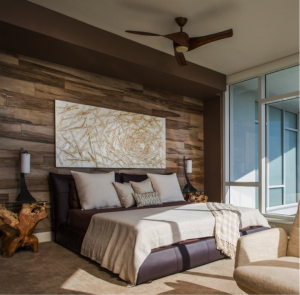
Feature Walls
Also called an accent wall, a feature wall is one that exhibits a different color or design than the other walls in the room. Expect to see an increased use of feature walls showcasing rich paint colors, bold patterned wallpaper, and textures brought in through millwork and shiplap.
Statement Lighting
Lighting will take center stage with distinctive fixtures, including local artisan and vintage pendants and chandeliers. And smart lighting technology will enable homeowners to customize their lighting experience based on time of day, activity and mood.
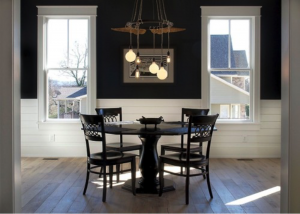
Hardwood Floors
Hardwood floors will continue to dominate the market. The trend is toward either very dark stains paired with light-colored walls or light stains with darker walls. Greyish tones will remain popular, as will matte finishes, which are easier to maintain than high gloss. Expect to see frequent use of wider and longer wood planks, as well as distressed and wire-brushed finishes, which add texture and dimension.
Smart Homes
Everything is getting “smarter” in homes, from locks and lights to thermostats and appliances. And with devices like Google Home and Amazon Alexa, you can control many of these with voice activation from a central hub. We will see continued integration of and advancements in smart-home technology in 2018.
KITCHEN TRENDS
While white kitchens will remain popular in 2018, expect to see more color this year in everything from cabinets to tile to appliances.
Two-toned Cabinets
Two-toned cabinets are quickly overtaking the white-on-white look that has dominated kitchen design for the past few years. While white remains a classic, grey and bleached-wood cabinet variations are surging in popularity, along with darker neutrals like navy and green.

Quartz Countertops
Granite reigned as the top countertop choice for many years, but quartz is now king. It’s highly durable, low-maintenance and comes in a wide variety of styles and colors. It’s also heat resistant, scratch resistant and non-porous (unlike granite and marble) so it doesn’t need to be sealed.
Bold Backsplashes
After years of dominating backsplash design, the white subway tile is officially on its way out. Expect to see it replaced with more elaborate shapes, patterns, colors and textures. Tile that mimics the appearance of wood, concrete and wallpaper is also gaining in popularity.
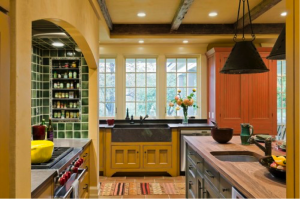
Statement Sinks
While stainless steel and white porcelain are always safe bets, the trend is moving toward sinks that make more of a statement. Look for unexpected pops of color and materials like natural stone and copper. Touch-free faucets are expected to gain favor with homeowners this year, too.
Brass is (Still) Back
Brass fixtures came back in a big way over the past couple of years and will continue to be a popular choice in 2018 along with matte black, black nickel, polished chrome and brushed nickel. Missing from the list? Rose gold, which is decidedly “out” this year.
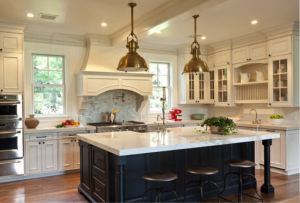
Multi-purpose Islands
Kitchen islands have evolved from simple prep-stations into the “workhorse” of the kitchen. Many feature sinks, built-in appliances and under-counter storage while also serving as a casual dining area. They have become the focal point of the kitchen, and we expect to see more of them in 2018 and beyond.
Black Stainless Steel
Black stainless steel is the hot new finish option for appliances, and it’s hitting the market in a big way. It offers a cutting-edge look and is easier to keep clean than traditional stainless steel. However, it’s harder to match finishes amongst different brands, so it’s probably only feasible as part of a complete appliance package.
Appliance Garages
Appliance garages are counter-level compartments designed to house small appliances like blenders, toasters and stand mixers. They make it convenient to have these items readily accessible, without the look of a cluttered counter.
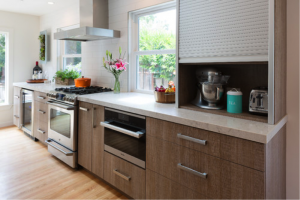
BATH TRENDS
Expect to see many of the same kitchen design preferences carry over into bathrooms this year, including two-tone cabinets, quartz countertops and brass fixtures.
Neutral Tones
Neutral shades will continue to dominate in the master bathroom as homeowners seek a soothing and relaxing retreat atmosphere. But expect to see more options than just white. Shades of brown, grey, blue, green and tan will help to warm things up.
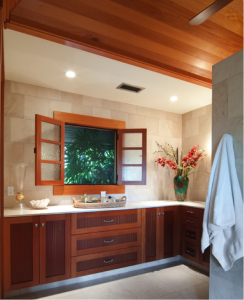
Natural Elements
Natural materials are particularly hot right now in bathroom design. This includes the use of wood and stone on walls, cabinets, counters and backsplashes, as well as the incorporation of botanical design elements.
Large Tiles
We expect to see a lot more large and slab-sized tiles in bathrooms, which have less grout so they are easier to clean and maintain. Wood-look porcelain tiles are also a favorite in wet areas, as they offer the warmth and rustic appeal of wood with the durability of tile.

Stone Sinks
Sinks will continue to be an area where homeowners like to exhibit creativity, and hand-carved stone sinks are especially fashionable right now. These may be more suited to powder rooms, where functionality isn’t as crucial.
Freestanding Tubs
There’s been a tub resurgence in bathroom design after years of preference for stand-alone showers. Modern tastes are gravitating toward freestanding tubs that serve as a showpiece for the bathroom.
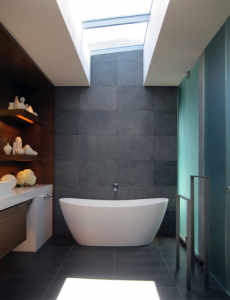
Smart Features
Smart technology has entered the bathroom with the addition of features like wireless shower speakers and high-tech toilets, as well as digital shower controls that automatically adjust to your preferences in temperature and spray intensity.
OUR ADVICE
Style trends come and go, so don’t invest in the latest look unless you love it. That said, highly-personalized or outdated style choices can limit the appeal of your property for resale.
For major renovation projects, it’s always a good idea to stick to neutral colors and classic styles. It will give your remodel longevity and appeal to the greatest number of buyers when it comes time to sell. It will also give you flexibility to update your look in a few years without a total overhaul. Use non-permanent fixtures – like paint, furniture and accent pieces – to personalize the space and incorporate trendier choices.
If you’d like advice on a specific remodelling or design project, give us a call at 303.475.6269! We’re happy to offer our insights and suggestions on how to maximize your return on investment and recommend local shops and service providers who may be able to assist you.
——-
Sources:
1. Country Living –
http://www.countryliving.com/home-design/decorating-ideas/g3988/kitchen-trends
2. Elle Decor –
http://www.elledecor.com/design-decorate/trends/g14486069/kitchen-trends-2018/
3. Gates Interior Design –
https://gatesinteriordesign.com/hottest-interior-design-trends-for-2018/
https://gatesinteriordesign.com/biggest-kitchen-bath-trends-for-2018/
4. HGTV.com –
http://www.hgtv.com/design/rooms/kitchens/17-top-kitchen-design-trends-pictures
5. House Beautiful –
http://www.housebeautiful.com/room-decorating/kitchens/g2664/kitchen-trends/
http://www.housebeautiful.com/design-inspiration/g13938283/2018-decor-trends/
http://www.housebeautiful.com/design-inspiration/g13820501/best-and-worst-decor-trends-from-2017/
6. Houzz –
https://www.houzz.com/ideabooks/93399913/list/interior-design-trends-expected-to-take-hold-in-2018
7. Huffington Post – http://www.huffingtonpost.com.au/2017/09/25/the-kitchen-and-dining-trends-to-look-out-for-in-2018_a_23222693/
8. Kitchen and Bath Design News –
http://www.kitchenbathdesign.com/123995/year-end-look-and-new-trends-for-2018/
9. MSN.com –
https://www.msn.com/en-us/lifestyle/home-and-garden/12-flooring-trends-for-2018/ss-AAtp7QA
10. Realtor.com –
https://www.realtor.com/advice/home-improvement/interior-design-trends-to-ditch-2018/
https://www.realtor.com/advice/home-improvement/hottest-interior-design-decor-trends-2018/?is_wp_site=1
11. Realty Times – http://realtytimes.com/advicefromagents/item/1007993-kitchen-design-trends-in-2018?rtmpage=MattLawler
12. Sebring Design Build –
https://sebringdesignbuild.com/top-trends-in-bathroom-design/
13. The Flooring Girl –
http://theflooringgirl.com/hardwood-flooring/hardwood-flooring-trends-2018/
14. Vogue –
https://www.vogue.com/article/interior-design-trends-according-to-expert-designers-decorators
by Farley Webmaster | Jan 10, 2018
As we head into a new year, the most common question we receive is, “What’s the outlook for real estate in 2018?”
It’s not just potential buyers and sellers who are curious; homeowners also want reassurance their home’s value is going up. The good news is that a strong U.S. economy, coupled with low unemployment rates, is expected to drive continued real estate growth in 2018. However, changes on the horizon could significantly impact you if you plan to buy, sell or refinance this year.
HOME VALUES WILL CONTINUE TO RISE
Get ready for another strong year! U.S. home values and sales volume will continue to rise in 2018.
Experts agree that home prices will increase in 2018, but predict a slower rate of appreciation than 2017, which clocked in at nearly 7 percent nationwide. National Association of Realtors (NAR) Chief Economist Lawrence Yun predicts a growth rate this year of 5.5 percent,1 while Freddie Mac’s September Outlook Report forecasts a rate of 4.9 percent. Either way, all indicators point towards continued growth in 2018.2
What does it mean for you? If you’re a current homeowner, congratulations! Real estate proves once again to be a solid investment over the long term. And if you’re considering selling this year, there’s never been a better time. Contact us to request a free Comparative Market Analysis to find out how much you can expect your home to sell for under current market conditions.
If you’re in the market to buy this year, there’s good news for you, too. Although prices continue to rise, the rate of appreciation has slowed. Still, don’t wait any longer. Prices will continue to go up, so you’ll pay more six months from now than you would today. Call us to setup a free, no-obligation property search and get notified about listings that meet your criteria as soon as (or before) they hit the market.
NEW CONSTRUCTION WILL MAKE REAL ESTATE MORE ACCESSIBLE
Lack of inventory in the housing market has been a primary impediment to homeownership for many Americans. “Ten years ago, the problem in the housing market was lack of buyers,” says Yun. “Today, the problem is lack of sellers. Inventory levels are near historic lows.”3
Yun also notes, “The lack of inventory has pushed up home prices by 48 percent from the low point in 2011, while wage growth over the same period has been only 15 percent. Despite improving confidence [in 2017] from renters that now is a good time to buy a home, the inability for them to do so is causing them to miss out on the significant wealth gains that homeowners have benefitted from through rising home values.”1
The good news? Yun expects a 9.4 percentage point increase in single-family new home construction starts.4
Economists at Freddie Mac make a similar prediction. “Existing home sales are unlikely to increase much going forward. Limited inventory will remain a consistent problem … Growth in home sales will be primarily driven by new home sales, which should continue to grind higher with single-family construction.”2
Robert Dietz, chief economist at the National Association of Home Builders, agrees. “The markets that are going to grow are ones where builders can add that entry level product.”5
What does it mean for you? If you’ve been frustrated by lack of inventory in the past, 2018 may bring new opportunities for you to find a budget-friendly home that suits your needs. Give us a call to discuss options for new construction in our area.
MILLENNIALS WILL MOVE TO THE SUBURBS
The new entry-level construction will come with a catch though … it will be located in the suburbs, where the availability of land and fewer zoning requirements make it more cost-effective to build. Economists predict that’s where millennials and first-time buyers will flock for the greater variety of homes at affordable prices.6
Rising home prices, a sluggish job market, and an increase in student loan debt made homeownership largely unattainable for many millennials in past years. However, there’s significant evidence that this trend is turning around. For the fourth year a row, the National Association of Realtors’ 2017 Home Buyer and Seller Generational Trends survey found that millennials were the largest group of homebuyers.7
As millennials age, they are settling down and having families, which has prompted an increasing demand for larger but affordable homes. Thus, many are flocking to the suburbs, with 57 percent of millennial buyers opting for a suburban location.
What does it mean for you? If you’re a millennial who has been priced out of urban living, or is looking for more space for your growing family, a number of suburbs in our area have a lot to offer. We can point you towards the communities that will best meet your needs.
And if you’re a suburban homeowner with plans to sell, give us a call. We know how to market your home to millennials … and can help you sell quickly for top dollar by appealing to this growing market segment!
BOOMERANG BUYERS WILL RETURN TO THE MARKET
“Boomerang buyers” comprise the nearly 10 million Americans who lost their homes to foreclosure or short sales during the housing recession of 2006 to 2014.
According to MyFico.com, a foreclosure remains on a credit report for seven years. It takes many boomerang buyers at least that long to raise their credit score and save up enough cash to qualify for a new mortgage.8
With this “seven-year window” in mind, RealtyTrac predicts that the largest wave of boomerang buyers – more than 1.3 million – will be eligible to re-enter the housing market in 2018.9
Markets likely to see the highest influx of boomerang buyers are those that had a high percentage of foreclosures AND have remained affordable. The majority of boomerang buyers are middle-class Gen Xers or Baby Boomers. Expect to see even more competition for entry-level homes in those markets.
What does it mean for you? If you’re a boomerang buyer, we understand your unique circumstances. We can help you navigate the real estate process and write competitive offers that will play to your strengths. Contact us to discuss your options.
NEW TAX LEGISLATION WILL IMPACT HOMEOWNER DEDUCTIONS
The “Tax Cuts and Jobs Act” passed at the end of 2017 nearly doubles the standard deduction, so far fewer Americans are expected to itemize this year. For those who do, however, it could mean less homeowner deductions are available than in the past.
Previously, homeowners could deduct interest paid on the first $1 million of mortgage debt, but that threshold has been lowered to $750,000 for new mortgages. (Existing mortgages will not be impacted.)
Additionally, taxpayers will no longer be able to fully deduct state and local property taxes plus income or sales taxes. The new legislation restricts this deduction to $10,000. It also eliminates the deduction for moving expenses (except for members of the Armed Forces) and interest on home equity loans unless the proceeds are used to substantially improve the residence.10
It’s yet to be seen how the tax bill will impact the real estate market overall. While some economists predict a price reduction in certain markets, Republican lawmakers project the bill will increase take-home pay and stimulate the economy overall. According to Realtor.com Senior Economist Joseph Kirchner, “Some house hunters—particularly wealthy buyers—will see an increase in after-tax income, making an already tough housing market even more competitive. This increased demand could drive prices up even higher than they are already.”11
What does it mean for you? If you’re an existing homeowner, be sure to consult a tax professional if you’re concerned about the impact the new tax bill could have on you.
And if you’re planning to buy or sell this year, we can help you determine how the tax bill could affect demand in your current or target neighborhood and price range.
INTEREST RATES WILL RISE
No one knows exactly what will happen with mortgage rates this year, but the Mortgage Bankers Association anticipates the Federal Reserve will raise rates three times in 2018, with Freddie Mac’s 30-year fixed rate mortgage reaching 4.8 percent by the end of Q4, up from around 4 percent at the end of 2017.12
Kiplinger.com Economist David Payne also predicts interests rates will rise this year, with short-term rates outpacing long-term rates as the Fed aims to curb inflation in a tightening job market. He predicts the bank prime rate that home equity loans are based on will increase from 4.25 percent to 5 percent by the end of 2018. 13
What does it mean for you? If you’re in the market to buy, act now. Rising interest rates will decrease your purchasing power, so act quickly before interest rates go up. Give us a call today to get your home search started.
And if you’re a current homeowner who is considering refinancing or a home equity loan, don’t wait. We can help you estimate your property’s fair market value so you’ll be prepared before contacting a lender.
2018 ACTION PLAN
If you plan to BUY this year:1. Get pre-approved for a mortgage. If you plan to finance part of your home purchase, getting pre-approved for a mortgage will give you a jump-start on the paperwork and provide an advantage over other buyers in a competitive market. The added bonus: you will find out how much you can afford to borrow and budget accordingly.
2. Create your wish list. How many bedrooms and bathrooms do you need? How far are you willing to commute to work? What’s most important to you in a home? We can set up a customized search that meets your criteria to help you find the perfect home for you.
3. Come to our office. The buying process can be tricky. We’d love to guide you through it. We can help you find a home that fits your needs and budget, all at no cost to you. Give us a call at 303.475.6269 to schedule an appointment today!
If you plan to SELL this year:
1. Call us for a FREE Comparative Market Analysis. A CMA not only gives you the current market value of your home, it’ll also show how your home compares to others in the area. This will help us determine which repairs and upgrades may be required to get top dollar for your property … and it will help us price your home correctly once you’re ready to list.
2. Prep your home for the market. Most buyers want a home they can move into right away, without having to make extensive repairs and upgrades. We can help you determine which ones are worth the time and expense to deliver maximum results.
3. Start decluttering. Help your buyers see themselves in your home by packing up personal items and things you don’t use regularly and storing them in an attic or storage locker. This will make your home appear larger, make it easier to stage … and get you one step closer to moving when the time comes! |
WE’RE HERE TO HELP
While national real estate numbers and predictions can provide a “big-picture” outlook for the year, real estate is local. And as local market experts, we can guide you through the ins and outs of our market, and the local issues that are likely to drive home values in your particular neighborhood. If you have specific questions, or would like more information about where we see real estate headed in our area, please give us a call at 303.475.6269 ! We’d love to discuss how issues here at home are likely to impact your desire to buy or a sell a home this year.
Sources:
- Inman News –
https://www.inman.com/2017/11/03/what-to-expect-from-the-2018-housing-market/
- Freddie Mac September Outlook Report –
http://www.freddiemac.com/research/outlook/20170921_looking_ahead_to_2018.html
- org –
https://www.marketplace.org/2017/07/05/economy/tight-inventory-slows-housing-market-down-0
- National Association of Realtors Press Release –
https://www.prnewswire.com/news-releases/existing-home-sales-to-grow-37-percent-in-2018-but-inventory-shortages-and-tax-reform-effects-loom-300549447.html
- Fox Business News –
http://www.foxbusiness.com/features/2017/11/27/entry-level-buyers-drive-solid-new-home-sales.html
- Zillow Research –
https://www.zillow.com/research/2018-predictions-17217/
- National Association of Realtors’ Home Buyer and Seller Generational Trends Report –
https://www.nar.realtor/research-and-statistics/research-reports/home-buyer-and-seller-generational-trends
- com –
https://www.myfico.com/crediteducation/questions/foreclosure-fico-score-affect.aspx
- RealtyTrac –
http://www.realtytrac.com/news/foreclosure-trends/boomerang-buyers/
- National Association of Realtors –
https://www.nar.realtor/taxes/tax-reform/the-tax-cuts-and-jobs-act-what-it-means-for-homeowners-and-real-estate-professionals
- com –
https://www.realtor.com/news/real-estate-news/tax-cuts-survey/
- Mortgage Bankers Association Economic Forecast –
https://www.mba.org/news-research-and-resources/research-and-economics/forecasts-and-commentary
- Kiplinger Economic Forecast –
https://www.kiplinger.com/article/business/T019-C000-S010-interest-rate-forecast.html#iOf4mkSFvvTmi2wr.99
by Farley Webmaster | Dec 13, 2017
Looking for the perfect present for a loved one this holiday season? We’ve rounded up 20 of our favorite gift ideas. And since we work in real estate, we focused on items that add enjoyment, comfort and, in some cases, major value to your home.
From music lovers to home chefs, we’ve got something for everyone. And we’ve included a range of price points to suit any budget, from under $50 to major splurge … in case you’re feeling extra generous this year. We hope you find this list useful in identifying gifts your friends and family will love. And maybe some of these items will make your wish list this year, too!
Approximate Price Ranges
$ – under $50
$$ – $51 to $200
$$$ – $201 to $500
$$$$ – Splurge
LET IT SNOW
Heat things up this holiday season! Keep your loved ones cozy all winter with these gifts that add warmth and a touch of luxury.
Tabletop Fireplace – $
On cold nights, nothing beats the comfort and glow of a fire. Whether you’re looking to cozy up on the couch with a good book, or enjoy a relaxing night in the backyard with family and friends, a tabletop fireplace is an easy way to light up your evening. The Regal Flame Black Utopia Tabletop Fireplace can be used indoors or outdoors, no vent required. It runs on ethanol, which can be mixed with citronella to double as a mosquito repellent for outdoor use.
Towel Warmer – $$
Who wouldn’t love to wrap themselves in a warm towel when they step out of the shower on a cold morning? While heated towel racks are available in a variety of styles and price points, the Anzzi Glow 4-Bar Electric Towel Warmer in Polished Chrome is an entry level version that gets good reviews. Modern and elegant, this model plugs into a nearby outlet for easy installation and is made of rust-resistant stainless steel. Turn your daily shower into a spa-like experience!
Smart Thermostat – $$$
Now you can wake up to a warm house, even if you like it cool while you sleep. After using the Nest Learning Thermostat for a week, it will start to recognize your patterns and adjust the temperature automatically to your preferences. In its third-generation, Nest claims to pay for itself over time in energy savings. It uses sensors and your phone’s location to check if you’ve left the house, then sets itself to an Eco Temperature. And this smart-thermostat knows when you typically get home from work and can heat things up before you return. If your schedule changes, you can even adjust the temperature remotely from your smartphone.
Radiant Floor Heating – $$$$
Radiant heating has been a popular alternative in new construction to traditional forced-air heating systems. And new technology has made it easier and less expensive to retrofit existing homes with radiant heating. According to BobVila.com, “radiant floors are heated either with electric resistance cables or hot water flowing inside tubing” beneath the floor. It’s energy-efficient, effective, and doesn’t blow dust and allergens around the way forced-air systems do. Not only will you love stepping onto a heated floor on a cool morning, you’ll be adding value to your home, as this is an appealing upgrade to buyers when it comes time to sell.
ROCK AROUND THE TREE
It’s holiday music time! Music lovers are sure to appreciate these gifts guaranteed to enhance their listening experience throughout the home.
Showerhead Speaker – $
Whether you enjoy singing in the shower, or listening to your favorite podcast, the H2oVibe Rain Showerhead Jet with Wireless Bluetooth Speaker syncs with any bluetooth-enabled device so you can stream your favorite music or other audio directly into the shower. The waterproof speaker easily detaches from the showerhead so you can bring it with you from room to room while you get dressed. And the showerhead itself features jets with three times more spray power than the average showerhead, creating a spa-like experience.
Voice Controlled Smart Speaker – $$
Smart speakers like Amazon Echo and Google Home not only stream music on demand via voice control, they can also serve as a central hub for numerous other smart-home devices. Now you can change the channel on your TV, make a phone call, turn on your lights, set your thermostat and lock your front door, all without lifting a finger.
High-End Wireless Speaker – $$$
If you prefer a premium speaker, the Sonos Play:3 is the mid-range option in the brand’s line of wireless speakers. It delivers rich and robust sound with a sleek design that can placed horizontally or vertically to fit almost any space. Sonos speakers sync with Amazon Echo and Alexa, which enable you to control the speaker with voice commands. And you can easily add additional speakers from the Sonos line for an enhanced, surround-sound experience.
Whole Home Audio System – $$$$
The sky’s the limit when it comes to whole-home audio systems, and for a premium sound system you can expect to make a significant investment. Companies like Yamaha offer a wide variety of components, all designed to work in conjunction to give you a customized whole-home audio and home theater system to suit your needs.
ADD SOME SIZZLE TO THE SEASON
Home chefs will love these gifts, perfect for holiday entertaining and home cooking all year long. Not only will they bring excitement to the recipient, everyone in the family will benefit from the delicious dishes these gifts are sure to inspire!
Bread Maker – $
Warm, fresh bread can make any meal feel special. With a bread machine like this one from Hamilton Beach, you can enjoy fresh rolls, pizza dough, cakes, jams, flatbreads and croissants with minimal effort. Plus, there’s a gluten-free setting, which makes this a perfect gift for anyone avoiding gluten in their diet.
Electric Smoker – $$
If you love to barbecue, the Char-Broil Deluxe Digital Electric Smoker gives you the tenderness and flavor of smoking meat, without the hassle. The integrated meat probe alerts you when the meat reaches a predetermined internal temperature, and when it’s done cooking the “warming” feature keeps your food hot until it’s ready to be served.
Smart Sous-Vide Machine – $$$
Sous vide is a method of cooking in which food is vacuum-sealed in a plastic pouch and then placed in a water bath to cook at a precise temperature. The new Mellow Smart Sous Vide Appliance hits the market this holiday season and promises to make sous vide as easy and foolproof as a slow cooker. Its built-in cooling system keeps your food cold until it’s ready to be cooked … so you can stick a piece of salmon in before you leave for work, choose the time you want it to be ready, and dinner will be done when you get home.
High-End Oven Range – $$$$
To really heat things up in the kitchen, any home chef would love a new high-end range, like this 36” Dual Fuel Range with Six Burners from Sub-Zero Wolf. With ten custom cooking modes—including one for proofing dough and one for dehydrating—and a temperature probe alert, this oven makes cooking almost foolproof. And the timeless stainless steel design will enhance the beauty of any kitchen. Investing in a high-end range not only adds enjoyment to meal preparation, it’s highly-desired by home buyers … something to consider if you plan to list your home within the next few years.
SPARKLE AND SHINE
Holiday lights aren’t the only way to make a home sparkle. These cleaning gadgets and appliances will keep your home clean and shiny all year long … and hopefully bring some joy to the cleaning process!
Portable Deep Carpet Cleaner – $
Anyone who has pets or young children will love the convenience of a cordless and portable spot cleaner like the BISSELL SpotLifter 2X Portable Deep Carpet Cleaner. Its cleaning brush agitates soiled spots while simultaneously sucking up debris. Use it to remove small spills and stains from carpet, furniture, rugs, drapes, car seats, and other upholstered items.
Robotic Vacuum Cleaner – $$
Robotic vacuum cleaners have been around for years, but new technology has made them more effective and lowered the cost significantly. The ECOVACS DEEBOT N79 Robotic Vacuum Cleaner provides a good mix of features and value. It offers several cleaning modes and moves easily from rugs to tile to carpet. You can also control it with your smartphone using the ECOVACS App.
Dishwasher – $$$
While a high-end dishwasher with all the bells and whistles can certainly be a good investment, there are some great values on the market for those with a more modest budget. For example, the Maytag Front Control Dishwasher gets consistently great reviews for its powerful motor that disintegrates bits of food to deliver sparkling clean dishes, even without rinsing. And its elegant exterior will upgrade the look of your kitchen … all without breaking the bank.
New Washer/Dryer – $$$$
If anything can make laundry exciting, it’s a new washer and dryer with smart-technology like the Kenmore Elite Smart Washer and Dryer. Now you can start a load of laundry remotely from your smartphone to time it with your arrival home. You can also customize washer and dryer cycles and receive an alert when a cycle is complete. And with the Express cycle, you can wash and dry a small load in 45 minutes, saving you time and energy.
KEEP THE GRINCH AWAY
Nothing is more important than the safety of you and your family. Protect your loved ones—and deter intruders—with gifts that keep you and your home safe and secure.
Smart Light Bulbs – $
The Philips Hue White Smart Bulb Starter Kit is a good entry-level investment in smart lighting technology. Now you can automate your lighting and control your lights from your smartphone using the Philips Hue App. Deter burglars by making it look like someone’s home when you turn your lights on remotely. And stay safer by never entering a dark house again. Plus, it has several options to enhance the look and ambiance of your home lighting.
Video Doorbell – $$
Watch over your home and greet visitors from your computer or smartphone with a video-enabled doorbell, like the Ring Video Doorbell 2. Adjustable motion sensors alert you when someone is approaching your door, and live video and audio allow you to see and talk to visitors without opening the door, even if you’re away from home. The best part is, they’ll never know you’re not home if you don’t tell them.
Smart Lock – $$$
Control and monitor your locks from anywhere with a smart lock like the August Smart Lock Pro + Connect. Now there’s no need to leave a key under the doormat or give a copy to the housekeeper. You can activate keyless access remotely, and even lock up when they leave, all from your computer or smartphone. And no more fumbling around for your keys in the dark. Similar to keyless entry for your car, Smart Lock Pro automatically unlocks your door when you approach.
Security System – $$$$
An in-home security system is still one of the best ways to protect your home and family from intruders and alert you to the presence of smoke or carbon monoxide. Some companies, like Vivint, can integrate your security system with video monitoring, a doorbell camera, smart locks, garage doors and even your thermostat. Prices vary depending on the options you select, and a monthly monitoring service is required, but a home security system can bring peace of mind knowing your family and home are protected.
WE’RE HERE TO HELP
As real estate professionals, we get to visit people’s homes every day and talk to buyers and sellers about their favorite features. So we have a unique insight into the elements that truly make a house special, bring joy to homeowners and add value to a home. Did we miss your favorite home-related gift? If so, we’d love to hear about it. Please share in the comments below!
If you do decide to “splurge” on a home upgrade, contact us for recommendations on the best options for your particular home. Buyer expectations and preferences vary depending on price point, style of home and neighborhood. We can run a comparative market analysis to find out how the upgrade you’re considering will impact the value of your home, before you make the investment.



